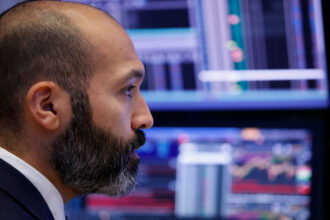© Reuters.
NEW YORK – The bond market has shown signs of stabilization and recovery as UBS successfully issued $3.5 billion in Additional Tier 1 (AT1) bonds last Wednesday. This issuance has been a significant step towards market normalization following the upheaval caused by the collapse of Credit Suisse in March.
The strong demand for UBS’s AT1 bonds was evident, with the final pricing set at 9.25% for both five- and ten-year call bonds. Initially, the price talk had suggested rates of 10% for the five-year and 10.125% for the ten-year call bonds. However, investor confidence, buoyed by the prospect of these bonds converting into equity under certain trigger events, allowed UBS to lower the final yield.
credit spreads are now close to the levels seen before Credit Suisse’s collapse. This sentiment was echoed by Jakub Lichwa from TwentyFour Asset Management, who pointed out the unprecedented demand that led to a book size of $36 billion.
Investor reassurance also came from UBS’s confirmation that these AT1 bonds would be convertible into equity in case of a trigger event, pending shareholder approval. This feature is a safeguard mechanism typical of AT1 instruments designed to absorb losses and preserve a bank’s capital base.
The successful bond issuance and the resulting high demand have been interpreted as positive indicators for the wider bond market. They suggest that investors are regaining confidence in the banking sector’s stability and are willing to invest in instruments that were previously under scrutiny due to Credit Suisse’s financial troubles.
InvestingPro Insights
UBS, a prominent player in the Capital Markets industry, has been maintaining a steady performance with some key metrics to note. As per InvestingPro’s real-time data, UBS has a market cap of 78099.92M USD and trades at a low earnings multiple, with a P/E ratio of 2.45 as of Q3 2023. The P/E ratio adjusted for the last twelve months as of Q3 2023 stands at 7.45.
From our InvestingPro Tips, it’s worth noting that despite some weak gross profit margins, UBS has managed to maintain dividend payments for 12 consecutive years, a reassuring sign for investors. Additionally, the company’s stockholders have been enjoying high returns on book equity.
For those interested in more insights, InvestingPro offers a wealth of additional tips and data metrics for UBS and other companies.
This article was generated with the support of AI and reviewed by an editor. For more information see our T&C.
Read the full article here










